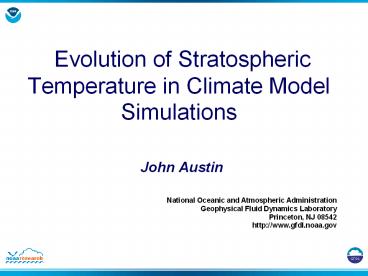Evolution of Stratospheric Temperature in Climate Model Simulations - PowerPoint PPT Presentation
Title:
Evolution of Stratospheric Temperature in Climate Model Simulations
Description:
Evolution of Stratospheric Temperature in ... Some runs have simplified tropospheric chemistry Some runs ... Description and runs Mean Ozone trend 1980 ... – PowerPoint PPT presentation
Number of Views:134
Avg rating:3.0/5.0
Title: Evolution of Stratospheric Temperature in Climate Model Simulations
1
Evolution of Stratospheric Temperature in
Climate Model Simulations
- John Austin
2
CCMval Description and runs
- Coupled chemistry-climate model simulations
- Uniform, observed forcings (solar, GHGs,
aerosols, SSTs/sea ice). - 12 different models complete climate models
with reasonably complete stratospheric chemistry. - Some runs have simplified tropospheric chemistry
- Some runs include several ensembles
- Period covered 1960-2050 mostly.
- Eyring et al. JGR, submitted.
3
(No Transcript)
4
Climatology of the final warming (S)
5
Monthly mean 50 hPa T
6
100 hPa seasonal variation
7
AMTRAC Description and runs
- GFDL climate model, coupled chemistry
- 48L model, upper boundary 0.002 hPa
- Horizontal resolution 2 x 2.5 deg.
- Finite Volume dynamical core
- Comprehensive stratospheric chemistry
simplified tropospheric chemistry - 3 member ensemble
- (1) 1960-2005 with observed forcings
- (2) 1990-2100 with A1B etc. forcings and SSTs
from GFDL IPCC runs.
8
(No Transcript)
9
Observed ozone trend
10
(No Transcript)
11
(No Transcript)
12
(No Transcript)
13
Temperature solar cycle
14
Ozone solar cycle
15
(No Transcript)
16
(No Transcript)
17
(No Transcript)
18
(No Transcript)
19
(No Transcript)
20
SOCOL MSU-4 equivalent temperature(25 months
running mean) courtesy Schnadt et al.
21
Conclusions
- Past T trends are in reasonable agreement with
observations for the period 1980-2000 in the
lower and upper stratosphere. - A solar cycle in T occurs in model results, but
is smaller than the SSU solar cycle. - In the global average, the lower stratosphere
temperature evolution agrees well with
observations. - Tropopause T decreases 1960-2005 (0.16 K/decade)
and increases thereafter (not shown) at 0.23
K/decade. - Much work is yet to be done within CCMval and on
individual models.































